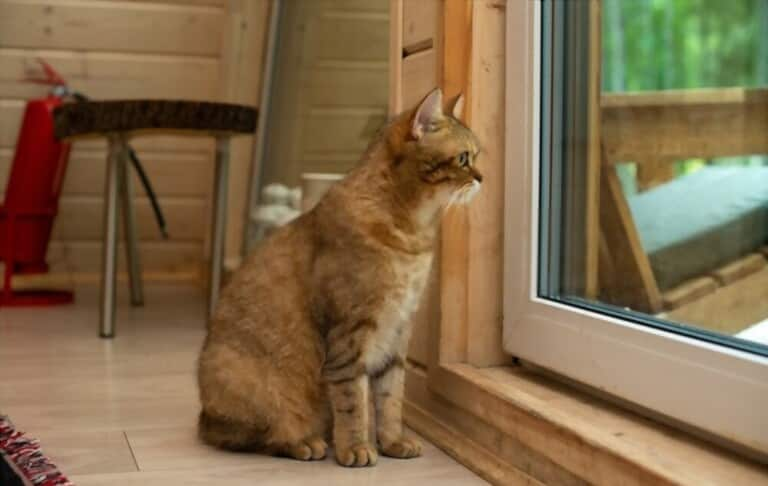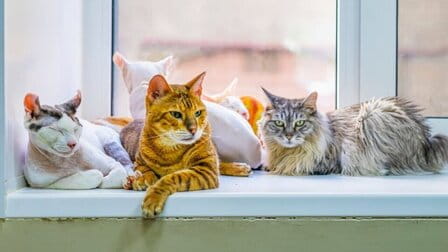In general, many pet owners are fascinated by the beauty and mystery of cat eyes, but imagine what it would be like to experience life with cat vision. How cats see the world, from whether cats can see colors to whether cats have night vision, let's find out with us below.
1. Visual field
Visual field refers to the area that can be seen when the eye is focused on a single point. They include what is visible directly ahead, including above, below, and to the side. Cats, on the other hand, have a slightly wider field of vision of 200 degrees than the average human visual field of 180 degrees.

2. Vision
It is known that visual acuity refers to the clarity of vision. The average human has a vision of 20/20. A cat's eyesight ranges from 20/100 to 20/200, meaning a cat must be 20 feet tall to see what the average person can see at 100 or 200 feet.
3. Color vision

There is a common misconception that cats cannot see any color and only see the world through shades of grey. Referring to humans as trichromats, that is, they have three types of cones that allow them to see red, green, and blue. On the other hand, cats are said to be tricolor creatures. Cats' vision is similar to that of humans with color blindness. They can see shades of blue and green, but red and pink can be confusing. In general, they can be greener, while purple can look like another shade of blue.
4. Distance
Most experts believe that cats are nearsighted, they cannot see distant objects. However, their ability to see objects up close is well-suited to hunting and capturing prey.
5. Night vision

Cats can't see fine details or rich colors, but cats have an outstanding ability to see in the dark because of the many neurons in the retina that are sensitive to dim light. As a result, cats can see about one-sixth as much light as humans need.
6. Cat's eye structure
Cats also have a structure behind the retina, called the tapetum, that improves night vision. The cells in the tapetum act like a mirror, reflecting the light passing between the rods and cones back to the photoreceptors and giving them another chance to pick up on the small amount of light available at night. This is the reason why cats' eyes glow in the dark.
Some questions say are cats color blind?
Cats can see some colors, but not the entire spectrum. In essence, cats are very much like color-blind people. Experts are divided on what colors cats can see but seem to see less saturated colors than humans. Domestic cats only see shades of blue and green, and like colorblind people, may not be able to tell the difference between red and green.
7. Cats have night vision
A cat's ability to see clearly in low light and at night is very important to cats. Cats have elliptical pupils, as opposed to the round pupils of humans. Elliptical pupils may be larger and open or close faster than circular pupils. The dilated pupils help cats see at night. Cats' superior night vision is thanks to the tapetum lucidum, a layer of tissue located just behind the retina. Tapetum lucidum reflects light and increases light availability to photoreceptors in the retina, which improves vision in low-light conditions.
8. Depth, motion and peripheral vision
Cat's eyes can detect even the slightest movement that will help them while hunting. They also can move their eyes extremely fast, allowing them to see and track their prey. Cats have binocular vision, so cats can see three-dimensionally, giving them the ability to perceive depth and determine the distance of objects. However, a cat's 3D vision is not as refined as a human's. Cats' bulging eyes give a greater peripheral vision than humans. Cat's vision is about 185 degrees, humans can only see about 120 degrees.
9. Cats are nearsighted

Cats are nearsighted and can see better up close than far. A cat can only see a few hundred meters away and the rest of the world is blurred out. Furthermore, cats can't see right below their noses either, which is why they sometimes have trouble finding a treat placed right in front of them.
10. Peripheral vision

Usually animals, the eyes can only see as much as they are positioned to see. Binocular vision with cats and dogs, but there are many differences between all of us. While a dog's eyes sometimes tend to be placed on the sides of the head, a cat's eyes are directed forward like a human's.
Cats have 20 degrees higher peripheral vision than humans, which is suitable for perceiving their surroundings. Moreover, they identify everything by motion, so the ability to detect motion is very important.
11. Night vision
Usually, we will wear special glasses to see at night, but cats do not. They evolved to hunt at night. A cat's eyes are exposed to a lot of light, which means that the pupils can dilate far beyond what we can do. If you've seen your cat's eyes fully dilate, you need to understand how extreme dilation can occur. Their eyes become all pupils. Overall, dilation isn't the only advantage cats have over humans at night. Their eyes capture and accumulate light inside the eye by bouncing it off a reflective layer under the retina. This layer is called the "tapetum" and it's responsible for creating the weird cat-eye glow/glow in the dark.
12. Color
There are usually cones in the retina. Because cats have only one-fifth of human cones, they mostly see black and white. They can also see blues and yellows, but they don't see saturated colors. As we said before, they depend on motion and contrast to define subjects.
13. Cat's ability to see
This is a term that refers to the ability to focus, and humans completely beat cats here. Cats have about 20-40% of our eyesight, which means they can't be as dependent on vision as we are. Cats are quite nearsighted, which happens when they hunt. In particular, they can smell and hear very well. They can rely on those two senses and use sight to confirm what they already know they are smelling or hearing.
Conclusion
There are many ways to describe how cats see the world, but there are still many questions raised and discussed around this issue. But between their hearing and their eyesight, it's not uncommon for cats to rule the world.













